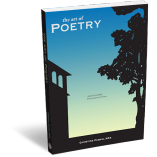“I dwell in Possibility—
A fairer House than Prose—”
This course features poet and professor Christine Perrin as she describes the major elements of poetry and also discusses them with four upper school students in a seminar format, therefore modeling how to teach poetry to students. In addition to familiarizing us with the forms and elements of poetry, Christine also shows us how to read a poem closely and absorb its beauty.
This course is based on her book The Art of Poetry, and each presentation will follow one of the chapters from this book.
About the Instructor
Christine Perrin has taught literature and creative writing at Johns Hopkins University, Messiah College, Gordon College’s Orvieto Program, through the Pennsylvania Arts Council to students of all ages, and at the local classical school where her husband was headmaster for a decade and where her children attended K–12. She consults with classical schools in curriculum development and faculty development in poetry and speaks regularly at the CIRCE Institute and Society for Classical Learning conferences. She is a two-time recipient of the PA Arts Council Artists Fellowship and a Bread Loaf Writer’s Conference Fellowship. Her own work appears in various journals, including The New England Review, Image, TriQuarterly, Blackbird, Christianity and Literature, and The Cresset. The Art of Poetry, a textbook for middle to high school students, was published in 2009 by Classical Academic Press. She is the content editor for Classical Academic Press for the Writing and Rhetoric curriculum series. She attended Johns Hopkins as an undergraduate and the University of Maryland for her MFA.

To learn more about earning a certificate for this course, please visit “How do I Obtain a Course Certificate?” on our FAQ page. Our course certificates are valued by classical schools and co-ops worldwide, and you can also be on your way to obtaining an elective credit toward a Level 2 certificate with your completion of this course. Teachers certified with either ACSI or ACCS will see continuing education unit (CEU) credits listed on our course certificate for you to submit to either organization (with more information on certification credit here).

This course is offered separately for transferable graduate credits through a partnership with the Templeton Honors College. When you are enrolled with Templeton, you will be assigned a professor with additional readings and course work beyond the video lecture content here, and you will complete your work within their university’s learning management system.




